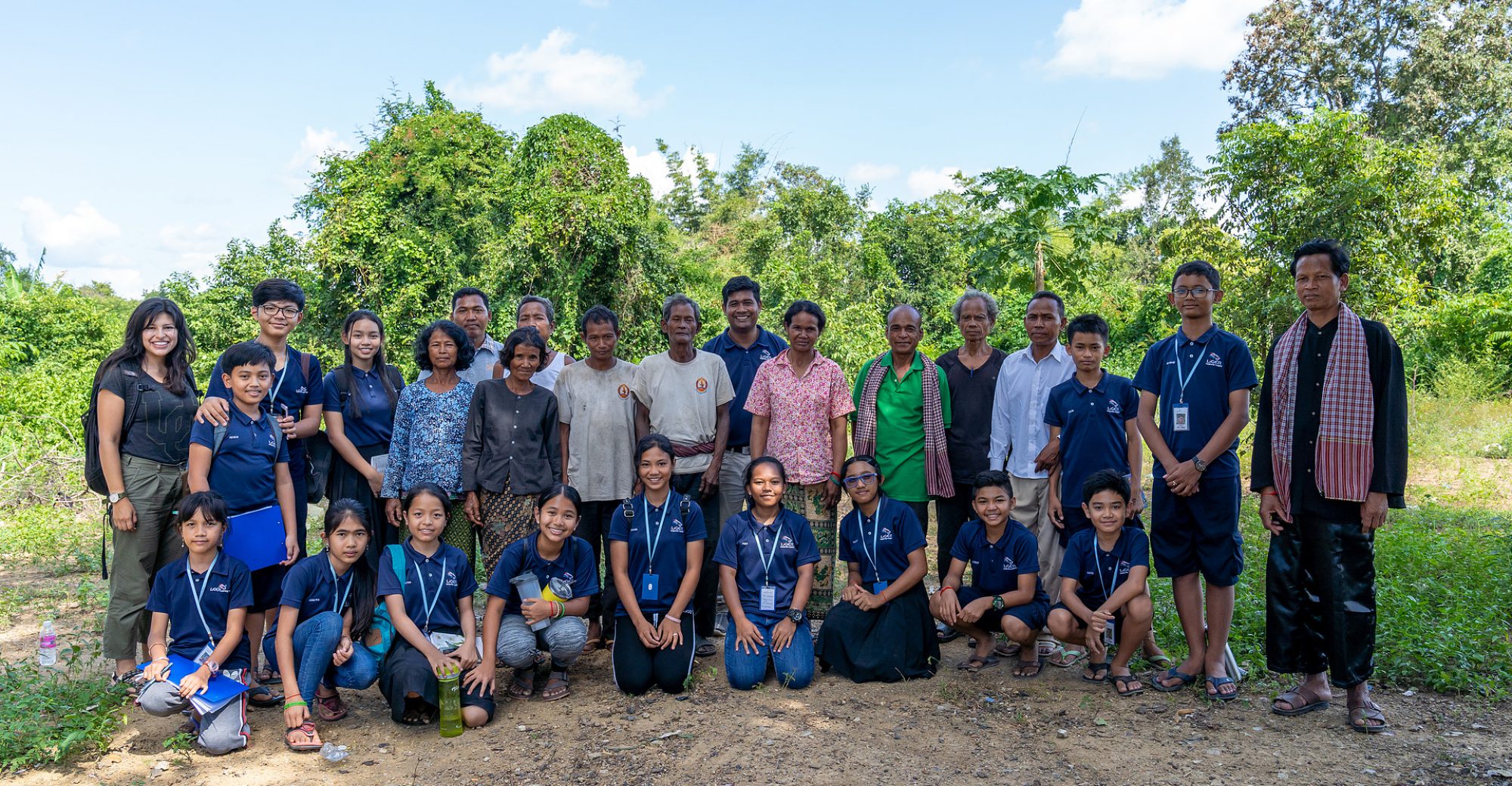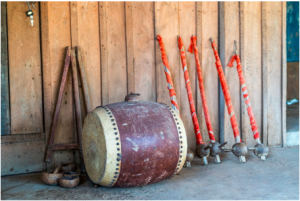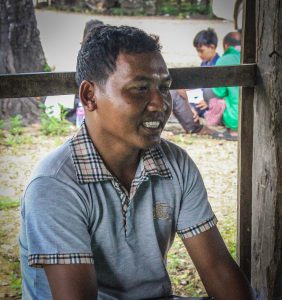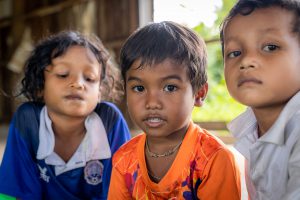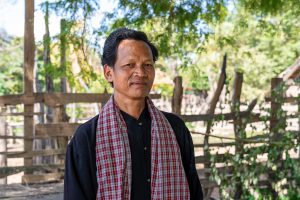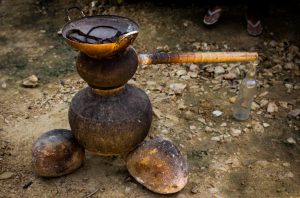Religion/ceremony
Souy indigenous people believe in buddhism and hinduism. Moreover, they also go to pagoda and celebrate some of the Khmer celebrations too. Those celebrations are Khmer new year, Pchum ben, and other ceremonies. However, they still have their traditional ceremony twice a year too. Those are called Sonom and Lerng Nak Ta.
Lerng Nak Ta
Souy community has a traditional festival which is the same as Cambodian. That is called Lerng Nak Ta. They celebrate it every dry season in between December and April. They believe that there are so many spirits in their community, so they have to do this event every year in order to rotate each of the spirit to look after the community each year (this is similar to the Khmer new year celebration where the angel rotates each year ). During this event, Souy people only speak their language, because they believe that it will bring them happiness and peace.
Belief on spirits
Souy community believe in the spirits and soul of the dead person that will come and protect them every time they need. Most of the people pray for happiness, peace, recovering from illness, harmony in family, and good luck. Other than that, there is a main spirit that a lot of people believe in too. People believe that there is a spirit at Te mountain that helps and protects all of the Souy people for a long time. According to an interview with an Aunty Ven Samin, 42 years old, living in Kordountey village, Chh-en commune, Aoral district, when she was young, she used to walk and climb the mountain (Te mountain). While walking, she got exhausted. She started to pray for the water from spirit. Suddenly, she saw a bowl of water in a copper cup. She was very happy at that moment because she got to drink water as she needed.
Belief in spirits
In the past, Souy community believed in spirit that existed in big trees and forest. If anyone wanted to cut down the trees without any permission from the Souy people, they would get sick for sure. This belief still exists nowadays. Besides the tree spirit, people also believe that if one of their relatives pass away, the soul of the dead person will come and look after them.
Other beliefs
Do you know
When a baby was born,
- Souy people always put thorn next to their babies to protect them from bad spirits who might come and scare their children.
- They use the quicklime to draw as a plus sign to protect the baby from bad spirits.
- They made a blessing string that embed with BongKong thorn to protect their baby when they grow up.
- If a baby cries, they will use a handful of rice to pray for the spirits, so they can get tolerance.
- If a baby gets sick, they will take him/her to the fortune teller for advice.
Sacred objects
In Souy community, they have two sacred objects. They are Sornom drum and hot water at Te Tek Pus. They believe that the object can help protecting them. The drum is really powerful for Souy community. Souy people are not allowed to touch the drum without permission. Other than that, we can not even take photo of it. If you don’t follow the norm and just take photo of whatever you want, your camera will not work anymore or you will have an accident. For the hot water, it can be used to cure a lot of illnesses.
Taboo
Souy people have taboo against eating some species that are warned by their spiritual guru that they trust. Example, if the spiritual gurus don’t allow them to eat dog meat, rabbit, snake or cow, the person must not eat those species.
Wedding
Once the people are grown enough for the age of marriage, Souy parents always prepare their children for a wedding day following their tradition. Women in Souy can get married at least at the age of 18 years old. The wedding will begin like this:
Before they become betrothed, there have to meet each other 4 times
- First meeting: consultation between parents from both side only
- Second meeting: consultation between both side of parents and the couple for betrothal
- Third meeting: consultation between both sides of parents, the couple, and the marriage broker for the dowry
- Last meeting: the consultation between both sides of parents, the couple and the relatives for getting to know each other
After going through all meetings, they will go to the fortune teller for a good day. Their wedding lasts three days:
- First day: they just start to make Aon-sorm (sticky rice cake wrapped with banana leaves), snack, and foods to prepare for the next two days
- Second day: is the big celebration for wedding. They follow their traditional customs for the wedding in order to be husband and wife. In the afternoon, they eat and drink wine with their neighbors and guests who they invited for the wedding.
- Last day: is the cleaning day.
Did you know?
- Souy people invite people to their wedding by using wine instead of invitation cards!
Funeral
According to Aunt Samin, once a person passed away, regardless of their old age or accident, the funeral may last between one to three days depending on the family. For the tradition, the dead can only be buried on the odd day such as the 1st, 3th, or 5th of the death. For any belongings that the dead person used, they would keep some of the them for the neighbors that needed it and some would be buried along with the body.
Beside that, Souy community also have the tradition of putting the coin in the body’s mouth. This means, when people die, they can not take their treasures and money with them even one cent.
During the funeral, the relatives of the dead person should also shave their hair, because they believed that the hair would be for a shade for the dead person. After the funeral, Souy community usually have the 7 and 100-day ceremony of the dead person to pray for the soul. In real life, it depends on the situation of the family, some people still have the one-year or two-year ceremony to commemorate the death of their relative.
Other ceremonies
Souy community is not only celebrating their traditional ceremony, but they also follow some of the Khmer ceremonies. Those ceremonies are Pchum ben, village festival, water festival, Khmer new year, and some of the other ceremonies that are related to Buddhism.
Head tribe
In Souy community, there is a leader that they call as the head tribe. As you know, the head tribe is the leader in the village leading activities. Those activities are such as preparing the festival or ceremony, giving detail information, gathering the villagers, and making sure that the ceremony is going smoothly. Besides that, the head tribe can also charge from whoever doing something against the Souy community’s traditions and norms.
ពិធីបុណ្យ និង ជំនឿ
ជនជាតិដើមភាគតិចសួយ មានជំនឿ ទៅលើព្រះពុទ្ធសាសនា និងព្រហ្មញ្ញសាសនា ។ មិនតែប៉ុណ្ណោះពួកគាត់ ថែមទាំងទៅវត្តអារាម ដើម្បីប្រារព្ធពិធីបុណ្យភ្ជុំបិណ្ឌ ចូលឆ្នាំខ្មែរ និងពិធីបុណ្យផ្សេងៗទៀតដូចជាជនជាតិខ្មែរយើងដែរ ។ បន្ថែមពីនេះ សួយមានពិធីបុណ្យធំៗចំនួនពីរគឺបុណ្យឡើងអ្នកតា និង បុណ្យសណំ ដែលត្រូវបានប្រារព្ធធ្វើឡើងជារៀងរាល់ឆ្នាំ ។
ពិធីបុណ្យឡើងអ្នកតា
សហគមន៍ជនជាតិសួយមានពិធីបុណ្យមួយដូចពិធីបុណ្យប្រពៃណីរបស់ជនជាតិខ្មែរដែរ គឺពិធីបុណ្យឡើងអ្នកតា។ ពួកគាត់ប្រារព្ធពិធីនេះនៅរដូវប្រាំង ។ ជនជាតិសួយមានជំនឿថា នៅក្នុងសហគមន៍របស់ពួកគាត់ មានអ្នកតាជាច្រើន ដូច្នេះពួកគាត់ត្រូវតែប្រារព្ធពិធីបុណ្យនេះដើម្បីផ្លាស់ប្តូរអ្នកតាមួយឆ្នាំម្ដងៗ ដូចដែលមានការផ្លាស់ប្តូរទេព្តានៅក្នុងពេលបុណ្យចូលឆ្នាំខ្មែរដែរ ។ នៅពេលដែលមានពិធីនេះពួកគាត់និយាយតែភាសាសួយប៉ុណ្ណោះដោយពួកគាត់ជឿជាក់ថានឹងនាំមកនូវសេចក្ដីសុខ ។
ជំនឿ
ជំនឿលើ អារក្ស អ្នកតា
សហគមន៍សួយមានជំនឿថាព្រលឹង វិញ្ញាណក្នុងមនុស្សដែលបានស្លាប់ទៅ និងព្រលឹងរបស់អារក្សអ្នកតានឹងជួយថែរក្សាការពារពួកគាត់។ ប្រជាជនភាគច្រើនបន់ស្រន់សុំឲ្យមានសេចក្ដីសុខ សន្តិភាព សុំលេខឆ្នោត ឆាប់ជាពីជម្ងឺ មានភាពសុខសប្បាយ ត្រជាក់ត្រជុំនៅក្នុងគ្រួសារ ។ ជាតួយ៉ាងពួកគាត់មានជំនឿទៅលើ អ្នកតាភ្នំទេដែលតែងតែជួយថែរក្សាពួកគាត់ជាដរាបមក ។ យោងតាមកិច្ចសម្ភាសន៍ជាមួយ អ៊ុំស្រី វ៉ែន សាមីន អាយុ ៤២ឆ្នាំដែលជាជនជាតិដើមភាគតិចសួយ នៅភូមិកោដូនតី្ត ឃុំ ឆ្អិន ស្រុកឪរ៉ាល់បានឲ្យដឹងថា កាលពីនៅក្មេង គាត់បានដើរឡើងភ្នំទេ ។ ធ្វើដំណើយូរៗទៅ គាត់បានស្រេកទឹកយ៉ាងខ្លាំង ពេលនោះគាត់បានបួងសួងសុំទឹកពីលោកតា ។ រំពេចនោះស្រាប់តែ គាត់បាន ឃើញទឹកក្នុងផ្ទិលស្ពាន់មួយ គាត់មានចិត្តត្រេកអរណាស់ហើយគាត់ក៏ហូបទឹកនោះទៅ។ ជំនឿលើព្រលឹង
កាលពីអតីតកាលជនជាតិដើមភាគតិចសួយមានជំនឿថាដើមឈើធំៗនិងព្រៃមានព្រលឹងវិញ្ញាណនៅក្នុងនោះ ។ ប្រសិនបើមាននរណាម្នាក់មកកាប់ដើមឈើ ដោយគ្មានការអនុញ្ញាតិ ពីជនជាតិសួយនោះទេ ពួកគេប្រាកដជាមានជំងឺឈឺថ្កាត់មិនខាន ។ រហូតមកដល់ពេលបច្ចុប្បន្ននេះ ពួកគាត់នៅតែបន្តមានជំនឿនោះដដែល ។បើយើងក្រឡេកមើលជំនឿទៅលើវិញ្ញាណអ្នកដែលបានស្លាប់វិញ បើសិនជាមានសមាជិកក្នុងគ្រួសារ ម្នាក់បានស្លាប់ ពួកគាត់មានជំនឿថាព្រលឹងអ្នកដែលបានស្លាប់នឹងមកថែរក្សាពួកគាត់នៅពេលក្រោយ ។
ជំនឿផ្សេងៗ
តើអ្នកដឹងទេ?
ពេលទារកទើបកើត
- ជនជាតិសួយតែងយកបន្លាមកដាក់ក្បែរទារកដើម្បីការពារពីព្រោះគាត់ពួកគាត់ខ្លាចព្រាយក្រឡាភ្លើងមកយាយី ។
- ពួកគាត់ក៏បានយកកំបោរទៅគូសជាសញ្ញាលេខបូកលើជញ្ជាំងផ្ទះ ដើម្បីកុំឲ្យខ្មោចឬវិញ្ញាណអាក្រក់ ចូលមកលងបន្លាចកូន ។
- ពួកគាត់ធ្វើខ្សែមន្តគាថាដែលមានបង្កប់បន្លាបង្កង់ដើម្បីការពារកូនពេលធំឡើង
- បើទារកយំខ្លាំង ពួកគាត់យកអង្ករ មកនិយាយបួងសួងសូមទោសទៅកាន់អារក្ស អ្នកតា កុំឲ្យខឹង នោះកូននឹងបាត់យំ ។
- បើក្មេងឈឺ ពួកគាត់នឹងទៅរកគ្រូទាយមើលពីផ្លូវងងឹត
វត្ថុសក្ដិសិទ្ធិ
នៅក្នុងសហគមន៍សួយមានវត្ថុសក្ដិសិទ្ធិចំនួន២គឺ ស្គរសណំ និង ទឹកក្តៅនៅកន្លែងទេទឹកពុះ។ គេមានជំនឿថាវត្ថុទាំងពីរនោះអាចការពារនិងមានឥទិ្ធពលចំពោះប្រជាជនជាខ្លាំង។ ប្រជាជនមិនអាចចូលទៅប៉ះពាល់ស្គរសណំ បានទេ បើសិនជាគ្មានការអនុញ្ញាតពីម្ចាស់អ្នកថែរក្សា (ដូនតា)។ បន្ថែមពីនេះសូម្បីតែថតរូបក៏ពួកគាត់មិនបានអនុញ្ញាត ដែរ។ បើសិនជាមិនប្រព្រឹត្តតាម ម៉ាស៊ីនថតរបស់អ្នកនឹងខូចឬ អ្នកនឹង មានគ្រោះថ្នាក់់ជាមិនខាន។ ចំពោះទេទឹកពុះវិញ ពួកគាត់ជឿថា ទឹកពុះនោះអាចយកមកព្យាបាលជម្ងឺផ្សេងៗបាន ។
តំំណម
ប្រជាជនសួយតែងមានតំណមទៅលើការបរិភោគសាច់សត្វមួយចំនួនដែលត្រូវបានហាមប្រាមដោយគ្រូអារក្សដែលពួកគេជឿតាម ។ ឧទាហរណ៍ បើសិនជាគ្រូហាមមិនឲ្យបរិភាគសាច់សុនខ សាច់ទន្សាយ គោឬក៏ពស់ នោះពួកគាត់ក៏មិនហ៊ានទទួលទានដែរ។អាពាហ៍ពិពាហ៍
នៅពេលដល់គ្រប់វ័យ រៀបមង្គលការ ជនជាតិដើមសួយក៏បានរៀបចំទុកដាក់កូនចៅ ទៅតាមទំនៀមទំលាប់ប្រពៃណីពីបុរាណមកដែរ ។ ស្រ្តីសួយដែលគ្រប់វ័យរៀបការបាន មានអាយុចាបើពី១៨ឆ្នាំឡើងទៅ ។ ឯទំនៀមទម្លាប់នៃអាពាហ៍ពិពាហ៍មានដូចតទៅ៖
មុននឹងឈានដល់ការចាប់ដៃគូរគ្នាជាប្តីប្រពន្ធ ឳពុកម្ដាយទាំងសងខាងត្រួវជួបគ្នាពិភាក្សាចំនួន៤ដងសិន៖
- ជំនួបលើកទី១ៈការជួបគ្នារវាងតែឳពុកម្ដាយទាំងសងខាងប៉ុណ្ណោះ។
- ជំនួបលើកទី២ៈការជួបរវាងឳពុកម្ដាយទាំងពីរថែមទាំងកូនប្រុសនិងស្រីជួបគ្នាដែរ។
- ជំនួបលើកទី៣ៈគឺការជួបគ្នារវាងឳពុកម្ដាយ កូនប្រុស ស្រីថែមទាំងអ្នកនិយាយបណ្ណាការ(មេអណ្ដើក) ពិភាក្សាគ្នាអំពីបណ្ណាការដែលត្រួវជូនខាងស្រី ។(បណ្ណាការរបស់ជនជាតិដើមភាគតិចសួយមានដូចជា ផ្ទះ គោ ក្របី និងស្រូវ ។)
- ជំនួបលើកទី៤ៈ គឺការជួបរវៀងឳពុកម្ដាយទាំងសងខាង កូនប្រុសនិងកូនស្រីថែមទាំងបងប្អូនទាំងអស់ ណែនាំឲ្យស្គាល់គ្នាទៅវិញទៅមក។បន្ទាប់ពីការជួបចុងក្រោយរបស់ពួកគាត់គ្រួសារទាំងសងខាងនឹងទៅជួបគ្រូខ្មែរឲ្យជួយរកវេលាល្អសម្រាប់ការរៀបការ។ ពិធីមង្គលការរបស់ពួកគាត់មានរយៈពេល៣ថ្ងៃៈ
- ថ្ងែដំបូងពួកគាតគ្រាន់តែធ្វើនំ និង ធ្វើម្ហូបអាហារសម្រាប់២ថ្ងៃទៀត។
- នៅថ្ងៃទី២ គឺជាថ្ងៃអាវាហៈមង្គលធំ។ ពួកគាត់ធ្វើអ្វីៗ
ទាំងអស់ទៅតាមពិធីកំណត់ដើម្បីក្លាយជាស្វាមីនិងភរិយានឹងគ្នា។ ហើយនៅពេលល្ងាចពួកគាត់និងបរិភោគអាហារ ជាមួយភ្ញៀវដែលមកចូលរួមពិធីការរបស់ពួកគាត់។
- នៅថ្ងៃចុងក្រោយពួកគាត់គ្រាន់តែរៀបចំផ្ទះនិងលាងចាន ។
តើអ្នកដឹងទេ?
ប្រជាជនសួយធ្វើការអញ្ជើញភ្ញៀវឲ្យចូលរួមមង្គលការ ដោយប្រើស្រាអញ្ជើញ ជំនួសអោយ ធៀបការ។
ពិធីបុណ្យសព
យោងតាមបទសម្ភាសរបស់អ៊ំស្រី សាមីន បានឲ្យដឹងថា នៅពេលដែលមានអ្នកបាត់បង់ជីវិតមិនថាដោយសារចាស់ជរាឬមានគ្រោះថ្នាក់ទេ ការរៀបចំបុណ្យសពអាចប្រារព្ធពី ១ទៅ៣ថ្ងៃ ទៅតាមលទ្ធភាពនៃគ្រួសារសព ។ បើតាមទំនៀមទម្លាប់សពអាចយកទៅកប់បាននៅថ្ងៃសេសតែប៉ុណ្ណោះ ដូចជាថ្ងៃដំបូង ឬ ថ្ងៃទីមួយ ថ្ងៃទីបី ឬ ថ្ងៃទីប្រាំនៃមរណកាល ។ ចំណែកឯ របស់របរប្រើប្រាស់ មានដូចជាសម្លៀកបំពាក់ និង វត្ថុប្រើប្រាស់ផ្សេងៗរបស់អ្នកដែលបានស្លាប់នឹងយកទៅឲ្យអ្នកដែលនៅរស់ប្រើប្រាស់បន្ដ ឬខ្លះទៀតយកទៅកប់ជាមួយសពនោះតែម្តង។មិនតែប៉ុណ្ណោះជនជាតិដើមភាគតិចសួយក៏មានទំនៀមទម្លាប់ដាក់កាក់ចូលមាត់បុគ្គលដែលបានបាត់បង់ជីវិតដែរ ។ ការដាក់កាក់ចូលក្នុងមាត់មានន័យថា មនុស្សស្លាប់ទៅហើយមិនអាចយកទ្រព្យសម្បត្តិទៅជាមួយបានទេសូម្បីតែ ប្រាក់មួយកាក់មួយសេន ។ក្នុងពិធីបុណ្យសពក៏មានការកោរសក់ដើម្បីឧទ្ទិសទៅដល់វិញ្ញាណក្ខន្ធអ្នកដែលបានស្លាប់ដែរ ។ ជនជាតិសួយមានជំនឿថាការកោរសក់នឹងនាំឲ្យបុគ្គលដែលស្លាប់មានម្លប់ជ្រក។ ក្រោយពេលស្លាប់ ជនជាតិសួយក៏មានប្រារព្ធពិធីបុណ្យ៧ថ្ងៃ និង ១០០ថ្ងៃដើម្បីឧទ្ទិសកុសលដល់វិញ្ញាណក្ខន្ធអ្នកដែលបាន ចែកឋានដែរ ។ អាស្រ័យលើលទ្ធភាពជាក់ស្តែង មានគ្រួសារនៃសពខ្លះក៏នៅតែប្រារព្ធពិធីបុណ្យគម្រប់ខួប១ឆ្នាំ ២ឆ្នាំ ជាដើម។
ពិធីបុណ្យផ្សេងៗ
ជនជាតិដើមភាគតិចសួយ មិនត្រឹមតែប្រារព្ធពិធីបុណ្យប្រពៃណីរបស់ពួកគាត់ទេ ពួកគាត់ថែមទាំងប្រារព្ធពិធីបុណ្យមួយចំនួនជាមួយជនជាតិខ្មែរយើងដែរ។ ពិធីបុណ្យទាំងនោះមានដូចជាពិធីបុណ្យភ្ជុំបិណ្ឌ ពិធីបុណ្យផ្កា បុណ្យភូមិ បុណ្យពិសាខបូជា មាឃបូជា ចូលឆ្នាំខ្មែរ និងពិធីបុណ្យអ៊ុំទូក ជាដើម ។
មេកន្ទ្រាញ
ក្នុងសហគមន៍សួយមានមេដឹកនាំម្នាក់ដែលគេហៅថា មេកន្ទ្រាញ ។ មេកន្ទ្រាញមានភារកិច្ចដឹកនាំសកម្មភាពផ្សេងៗនៅក្នុងភូមិ។ សកម្មភាពទាំងនោះមានដូចជា ការដឹកនាំធ្វើពិធីបុណ្យប្រពៃណី ការចាត់ចែងក្នុងកម្មវិធីបុណ្យ ការផ្តល់ព័ត៌មានអំពីពិធីបុណ្យ និងការប្រមូលអ្នកភូមិមកជួបជុំគ្នា ពេលមានកម្មវិធីបុណ្យ ជាដើម ។ មិនត្រឹមតែប៉ុណ្ណោះ មេកន្រ្ទាញ ក៏មានសិទ្ធិ ផាកពិន័យទៅលើអ្នកដែលបានធ្វើខុសចំពោះប្រពៃណី ទំនៀមទម្លាប់សួយផងដែរ។
